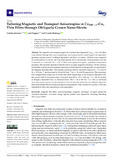Mostrar el registro sencillo del ítem
Tailoring magnetic and transport anisotropies in Co100−x –Cux thin films through obliquely grown nano-sheets
| dc.creator | Favieres Ruiz, Cristina | es_ES |
| dc.creator | Vergara Platero, José | es_ES |
| dc.creator | Madurga Pérez, Vicente | es_ES |
| dc.date.accessioned | 2022-04-12T10:44:02Z | |
| dc.date.available | 2022-04-12T10:44:02Z | |
| dc.date.issued | 2022 | |
| dc.identifier.issn | 2312-7481 | |
| dc.identifier.uri | https://hdl.handle.net/2454/42758 | |
| dc.description.abstract | The magnetic and transport properties of pulsed laser-deposited Co100−x –Cux thin films were tailored through their nano-morphology and composition by controlling for the deposition geometry, namely normal or oblique deposition, and their Cu content. All films were composed of an amorphous Co matrix and a textured growth of Cu nanocrystals, whose presence and size d increased as x increased. For x = 50, all films were superparamagnetic, regardless of deposition geometry. The normally deposited films showed no in-plane magnetic anisotropy. On the contrary, controllable in-plane uniaxial magnetic anisotropy in both direction and magnitude was generated in the obliquely deposited films. The magnetic anisotropy field Hk remained constant for x = 0, 5 and 10, Hk ≈ 35 kAm−1, and decreased to 28 and 26 kAm−1 for x = 20 and 30, respectively. This anisotropy had a magnetostatic origin due to a tilted nano-sheet morphology. In the normally deposited films, the coercive field Hc increased when x increased, from 200 (x = 0) to 1100 Am−1 (x = 30). In contrast, in obliquely deposited films, Hc decreased from 1500 (x = 0) to 100 Am−1 (x = 30) as x increased. Activation energy spectra corresponding to structural relaxation phenomena in obliquely deposited films were obtained from transport property measurements. They revealed two peaks, which also depended on their nano-morphology and composition. | en |
| dc.description.sponsorship | Financial support from the Public University of Navarre. | en |
| dc.format.extent | 23 p. | |
| dc.format.mimetype | application/pdf | en |
| dc.language.iso | eng | en |
| dc.publisher | MDPI | en |
| dc.relation.ispartof | Magnetochemistry, 8 (1), 2022 | en |
| dc.rights | © 2021 by the authors. Creative Commons Attribution 4.0 International | en |
| dc.rights.uri | http://creativecommons.org/licenses/by/4.0/ | |
| dc.subject | Activation energy spectra | en |
| dc.subject | Magnetic anisotropy | en |
| dc.subject | Magnetic thin films | en |
| dc.subject | Nano-morphology | en |
| dc.subject | Pulsed laser deposition | en |
| dc.subject | Scanning Tunneling Microscopy (STM) | en |
| dc.subject | Structural relaxation | en |
| dc.subject | Transport properties | en |
| dc.title | Tailoring magnetic and transport anisotropies in Co100−x –Cux thin films through obliquely grown nano-sheets | en |
| dc.type | info:eu-repo/semantics/article | en |
| dc.type | Artículo / Artikulua | es |
| dc.contributor.department | Ciencias | es_ES |
| dc.contributor.department | Zientziak | eu |
| dc.contributor.department | Institute for Advanced Materials and Mathematics - INAMAT2 | es_ES |
| dc.rights.accessRights | info:eu-repo/semantics/openAccess | en |
| dc.rights.accessRights | Acceso abierto / Sarbide irekia | es |
| dc.identifier.doi | 10.3390/magnetochemistry8010004 | |
| dc.relation.publisherversion | https://doi.org/10.3390/magnetochemistry8010004 | |
| dc.type.version | info:eu-repo/semantics/publishedVersion | en |
| dc.type.version | Versión publicada / Argitaratu den bertsioa | es |
| dc.contributor.funder | Universidad Pública de Navarra / Nafarroako Unibertsitate Publikoa | es |



